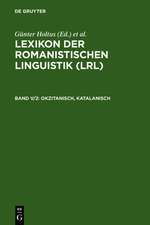Applied Translation Studies
Autor Tong King Leeen Limba Engleză Paperback – 23 oct 2017
Preț: 195.64 lei
Preț vechi: 244.97 lei
-20% Nou
Puncte Express: 293
Preț estimativ în valută:
37.44€ • 39.18$ • 31.16£
37.44€ • 39.18$ • 31.16£
Carte disponibilă
Livrare economică 10-24 martie
Preluare comenzi: 021 569.72.76
Specificații
ISBN-13: 9781137606082
ISBN-10: 1137606088
Pagini: 178
Ilustrații: 150 bw illus
Dimensiuni: 148 x 210 x 15 mm
Greutate: 0.23 kg
Ediția:1st ed. 2018
Editura: Bloomsbury Publishing
Colecția Red Globe Press
Locul publicării:London, United Kingdom
ISBN-10: 1137606088
Pagini: 178
Ilustrații: 150 bw illus
Dimensiuni: 148 x 210 x 15 mm
Greutate: 0.23 kg
Ediția:1st ed. 2018
Editura: Bloomsbury Publishing
Colecția Red Globe Press
Locul publicării:London, United Kingdom
Caracteristici
Covers a wide range of theories and applied approaches, all of which are treated in an even-handed manner, encouraging reflection and critical thinking
Notă biografică
Tong King Lee is an applied linguist based at the University of Hong Kong. He is a NAATI-accredited professional translator, with several years' experience in translation research and teaching as well as language consultancy. He is the author of the monographs Experimental Chinese Literature: Translation, Technology, Poetics (2015) and Translating the Multilingual City: Crosslingual Practices and Language Ideology (2013), and has published widely in leading international journals on applied linguistics and translation studies, including Applied Linguistics Review, Target, Translation Studies, The Translator, and Meta.
Cuprins
Chapter 1:Introduction Translation: Why even bother about it? Translation studies: The applied vs. the conceptual Applied translation studies: Three paradigms Further reading and reflection Chapter 2 :The Equivalence Paradigm Topic Map In pursuit of equivalence Shifting between languages Formal vs. dynamic equivalence Dynamic equivalence at work: Some illustrations The translator's liberty Semantic vs. communicative translation (Un)translatability and its discontents Further reading and reflection Chapter 3:The Functionalist Paradigm Topic Map The uses and users of text Text-type theory Translatorial action Translatorial action in crosscultural publishing: An example Skopos theory Translation as language solution Further real-life applications Translaboration (Translation + Collaboration) On clients and end-users Research as a component of translatorial action Translation as genetic transfer Localisation When books and movies travel Translation and global marketing communications: Apple Inc. Further reading and reflection Chapter 4:The Discourse Paradigm Topic Map Discourse: A plural concept The structure of texts: Baker's analysis Thematic patterning Markedness Information structure Cohesion: Reference, substitution/ellipsis, conjunction Cohesion: Multimodal discourse Register analysis: Hatim and Mason's model Measuring translation quality: House's model Case analysis of Chief Campaigner's speech in InspiringHK Sports Foundation annual report Further reading and reflection Chapter 5:Beyond the Paradigms Integrating the paradigms Beyond the word The translational: From translation to translanguaging Moving on from the applied: Conceptual articulations
Recenzii
Tong King Lee's new book sets to reshape the field of translation studies for the 21st century. It's intellectually stimulating and empirically rich. The variety of examples and theories make it an enjoyable and rewarding reading.
This book introduces foundational constructs in a clear and engaging way. It also features a great range of exemplars from different languages. It will serve as an indispensable orientation to Applied Translation Studies for the newcomer and a refreshing synthesis of key ideas for the more experienced reader.
Applied Translation Studies (ATS) is a comprehensive introduction to translation studies for those who are interested in learning the 'how' of text translation . After using a more conventionally-structured introduction to translation studies for three years, I started to work with ATS in 2018. My students participated in classroom discussions more enthusiastically when I used this book. I think this is because ATS lets students analyse translation through the perspective of intercultural communication, language use, language contact, diversity, the hegemony of English, and multilingualism. ATS is concise, easily digestible, and serves as a stimulating and thought-provoking textbook for introducing translation studies and guiding translators.
This book provides the student of the field with a comprehensive and concise panorama of its applications across the closely intertwined paradigms of equivalence, function, and discourse . The book covers a broad swath of approaches to the study of language contact, as it is revealed in translation: from the practical issues of the applied subfield to the radical postmodern proposals of Judith Butler.
This book introduces foundational constructs in a clear and engaging way. It also features a great range of exemplars from different languages. It will serve as an indispensable orientation to Applied Translation Studies for the newcomer and a refreshing synthesis of key ideas for the more experienced reader.
Applied Translation Studies (ATS) is a comprehensive introduction to translation studies for those who are interested in learning the 'how' of text translation . After using a more conventionally-structured introduction to translation studies for three years, I started to work with ATS in 2018. My students participated in classroom discussions more enthusiastically when I used this book. I think this is because ATS lets students analyse translation through the perspective of intercultural communication, language use, language contact, diversity, the hegemony of English, and multilingualism. ATS is concise, easily digestible, and serves as a stimulating and thought-provoking textbook for introducing translation studies and guiding translators.
This book provides the student of the field with a comprehensive and concise panorama of its applications across the closely intertwined paradigms of equivalence, function, and discourse . The book covers a broad swath of approaches to the study of language contact, as it is revealed in translation: from the practical issues of the applied subfield to the radical postmodern proposals of Judith Butler.




















